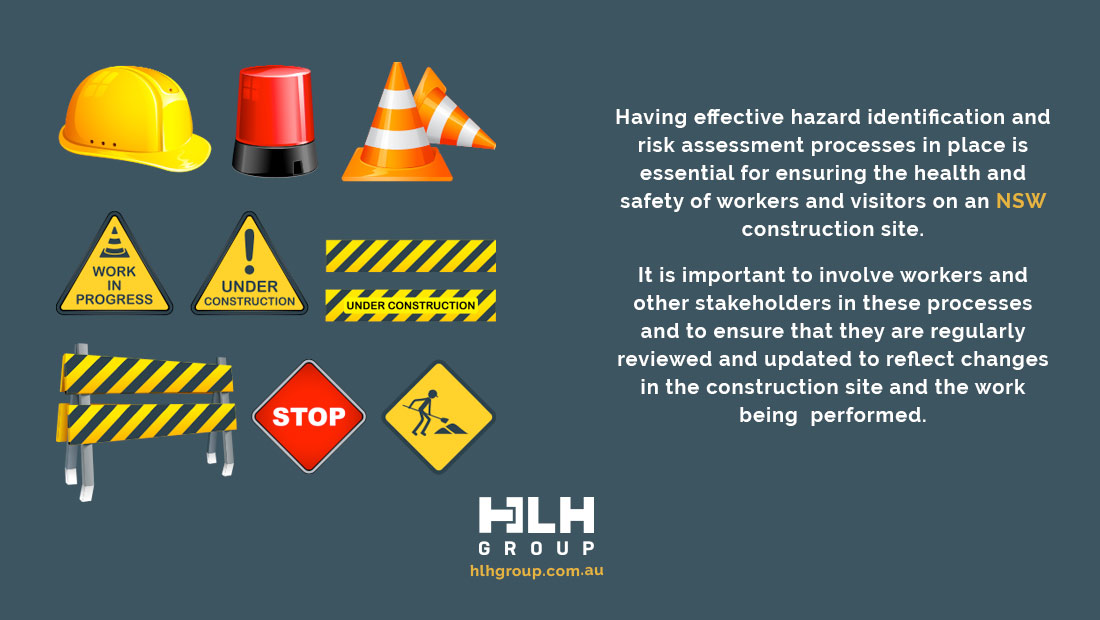
09 Mar 10 Essential Safety Measures Every NSW Construction Site Should Have
Essential Safety Measures for NSW Construction Sites
In this post our safety officer Pat will break down 10 essential safety measures every NSW construction site should have.
1. Hazard Identification and Risk Assessment Processes to Identify and Manage Risks
Hazard identification and risk assessment processes are crucial on an NSW construction site for the following reasons:
- Identifying Hazards: Hazard identification helps to identify potential hazards on the construction site, such as excavation areas, heavy machinery, and live electrical equipment, enabling appropriate control measures to be put in place.
- Assessing Risks: Risk assessment is the process of evaluating the likelihood and potential impact of identified hazards and determining the most effective way to control or eliminate the risk.
- Improving Safety: Hazard identification and risk assessment processes help to improve safety on the construction site by enabling the identification and control of hazards before they cause harm.
- Compliance with Regulations: Hazard identification and risk assessment processes are a requirement under health and safety regulations in NSW, and failure to comply can result in penalties and legal action.
- Continuous Improvement: Regularly reviewing and updating hazard identification and risk assessment processes help to ensure that the construction site remains safe and that any new hazards or risks are identified and managed effectively.

2. Appropriate Personal Protective Equipment (PPE) for Workers
Appropriate personal protective equipment (PPE) including hard hats, safety glasses, and high-visibility clothing is important on an NSW construction site for several reasons:
- Physical Protection: PPE, such as hard hats, safety glasses, and high-visibility clothing, protects workers from physical harm, such as head injuries, cuts, and abrasions.
- Compliance with Regulations: Providing appropriate PPE for workers is a requirement under health and safety regulations in NSW, and failure to do so can result in penalties and legal action.
- Improved Safety Culture: Providing appropriate PPE for workers demonstrates a commitment to health and safety and encourages a positive safety culture among workers.
- Enhanced Visibility: High-visibility clothing improves the visibility of workers, reducing the risk of accidents and collisions with vehicles and other hazards.
- Specialized Protection: Depending on the type of work being performed, specialized PPE may be required, such as respirators, ear protection, or chemical-resistant gloves, to protect workers from specific hazards.

3. Regular Safety Inspections and Audits
Regular safety inspections and audits to identify and rectify hazards and maintain a safe working environment are important on an NSW construction site for several reasons:
- Identifying Hazards: Regular inspections and audits help to identify potential hazards and unsafe conditions on the construction site, enabling appropriate control measures to be put in place.
- Maintaining a Safe Working Environment: Regular inspections and audits help to maintain a safe working environment by ensuring that hazards are identified and controlled and that workers and visitors are protected from harm.
- Compliance with Regulations: Regular safety inspections and audits are a requirement under health and safety regulations in NSW, and failure to comply can result in penalties and legal action.
- Continuous Improvement: Regularly reviewing and updating safety inspection and audit processes help to ensure that the construction site remains safe and that any new hazards or risks are identified and managed effectively.
- Enhancing Worker Confidence: Regular safety inspections and audits can increase worker confidence in the health and safety measures in place and demonstrate a commitment to their well-being.
4. Adequate Fencing and Signage>
Adequate fencing and signage on an NSW construction site serve several important safety functions:
- Security: Fencing helps to secure the site and prevent unauthorized access, which can reduce the risk of theft, damage, and injury.
- Hazard Warning: Signage can be used to warn workers and visitors of potential hazards on the site, such as excavation areas, heavy machinery, and live electrical equipment.
- Site Boundary: Fencing can clearly define the boundary of the construction site, helping workers and visitors to understand where the site starts and ends.
- Traffic Control: Fencing can help to control and direct vehicle and pedestrian traffic on and around the site, reducing the risk of accidents and collisions.
- Safety Barrier: In some cases, fencing can also provide a physical barrier to prevent workers and visitors from coming into contact with hazardous areas.
5. Effective Fire Safety Measures
Effective fire safety measures, including fire extinguishers, fire blankets, and fire alarms, are essential on an NSW construction site because they help to prevent and manage the risk of fire, which can cause serious harm to workers, visitors, and the surrounding environment.
- Fire Extinguishers: Portable fire extinguishers can be used to quickly extinguish small fires before they get out of control.
- Fire Blankets: Fire blankets can be used to smother small fires, such as kitchen fires, and prevent the spread of flames.
- Fire Alarms: Fire alarms help to quickly alert workers and visitors to a fire, enabling them to evacuate the site safely and quickly.
6. Safe Access and Egress Routes
Safe access and egress routes, including emergency exits, are crucial on an NSW construction site for the following reasons:
- Emergency Evacuation: In the event of an emergency, such as a fire or hazardous incident, safe access and egress routes, including emergency exits, enable workers and visitors to evacuate the site quickly and safely.
- Avoiding Hazards: Providing safe access and egress routes helps workers and visitors to avoid hazards on the site, such as excavation areas, heavy machinery, and live electrical equipment.
- Preventing Accidents: Safe access and egress routes can prevent accidents, such as falls and trips, by providing a clear and level pathway for workers and visitors to move around the site.
- Maintaining Safety: Regularly inspecting and maintaining access and egress routes helps to ensure that they remain safe and accessible at all times.
7. Adequate Lighting
Adequate lighting is important on an NSW construction site for several reasons:
- Improved Visibility: Adequate lighting helps workers and visitors to see clearly, reducing the risk of accidents and injuries caused by tripping, falling, or colliding with objects.
- Enhanced Safety: Adequate lighting can improve safety by highlighting hazards and potential trip hazards, such as excavation areas, heavy machinery, and electrical equipment.
- Improved Productivity: Adequate lighting can also improve productivity by enabling workers to see what they are doing and work more efficiently.
- Emergency Response: Adequate lighting can aid emergency response by enabling workers to see clearly in the event of an emergency, such as a fire or hazardous incident.

8. First-aid Facilities
First-aid facilities, including first-aid kits and trained first-aiders, are essential on an NSW construction site for the following reasons:
- Emergency Response: In the event of an injury or illness, having first-aid facilities and trained first-aiders can provide immediate and appropriate care, reducing the severity of the injury and improving the chances of a successful recovery.
- Compliance with Regulations: Providing first-aid facilities and trained first-aiders is a requirement under health and safety regulations in NSW, and failure to do so can result in penalties and legal action.
- Improved Safety Culture: Having first-aid facilities and trained first-aiders on site can demonstrate a commitment to health and safety and encourage a positive safety culture among workers.
- Peace of Mind: Providing first-aid facilities and trained first-aiders can give workers and visitors peace of mind, knowing that they will receive prompt and effective care in the event of an injury or illness.
9. Effective Waste Management
Effective waste management procedures are important in construction sites in New South Wales (NSW) to prevent contamination and injury due to several reasons:
- Environmental Protection: Improper disposal of waste can lead to pollution of soil, water, and air, which can have negative impacts on the environment and human health.
- Health and Safety: In construction sites, there may be hazardous materials such as chemicals, batteries, and medical waste that require special handling to prevent injury and illnesses to workers and the public.
- Legal Compliance: The NSW government has regulations in place for the proper disposal of waste, and failure to comply with these regulations can result in penalties and legal action.
10. Safe Storage of Dangerous Goods & Chemicals
Safe storage of dangerous goods and chemicals is important on an NSW construction site for several reasons:
- Prevention of Harm: Proper storage of dangerous goods and chemicals helps to prevent accidents, fires, and releases of hazardous substances, which can harm workers, visitors, and the environment.
- Compliance with Regulations: Safe storage of dangerous goods and chemicals is a requirement under health and safety regulations in NSW, and failure to comply can result in penalties and legal action.
- Protection of the Environment: Safe storage of dangerous goods and chemicals helps to prevent releases into the environment, which can have harmful impacts on air, water, and soil quality.
- Improved Safety Culture: Proper storage of dangerous goods and chemicals demonstrates a commitment to health and safety and encourages a positive safety culture among workers.
- Efficient Operations: Safe storage of dangerous goods and chemicals helps to ensure that these materials are stored and handled in a way that allows for efficient and safe operations on the construction site.
Benefits of Safety Measures on a Construction Site
If the ten essential safety measures are followed on an NSW construction site, several benefits can be realized, including:
- Improved Health and Safety: Adhering to the essential safety measures helps to ensure that workers and visitors are protected from harm and reduces the risk of accidents and injuries.
- Compliance with Regulations: Following the essential safety measures helps to ensure compliance with health and safety regulations in NSW, reducing the risk of penalties and legal action.
- Enhanced Safety Culture: Implementing the essential safety measures demonstrates a commitment to health and safety and encourages a positive safety culture among workers.
- Efficient Operations: By managing risks and controlling hazards, the essential safety measures help to ensure that operations on the construction site are efficient and safe.
- Increased Confidence: By ensuring a safe working environment, the essential safety measures can increase worker confidence in the health and safety measures in place, and reduce the risk of incidents and accidents.

Construction Site Safety Measures – Conclusions
In conclusion, following the ten essential safety measures on an NSW construction site is essential for ensuring the health and safety of workers and visitors, and for maintaining a safe working environment. It is important to regularly review and update these measures to ensure they remain effective and relevant, and to involve workers and other stakeholders in this process.




No Comments